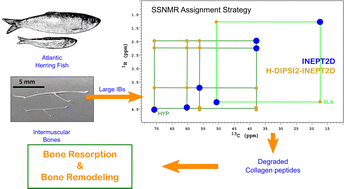Our lab provides a new tool for detecting bone resorption with solid-state NMR
Here, we focused on the mobile phase of the bone vascular system by carefully preserving moisture in adult Atlantic herring intermuscular bones. We detected pore water with high ionic strength and soluble degraded peptides whose 1H-transverse relaxation times, T2s, exceed 15 milliseconds. With favorable T2s, we incorporated a solution state spinlock scheme into the INEPT techniques to unequivocally demonstrate collagen degradation. In addition, we detected a substantial amount of inorganic phosphate in solution with 31P-NMR in the considerable background of solid hydroxyapatite calcium phosphate by saturation recovery experiment. It is consistent with the idea that bone resorption degrades bone collagen and releases calcium and phosphate ions in the pore water with increased ionic strength. Our report is the first to probe the resorption process in the heterogenous bone microstructure with a rigorous characterization of 1H and 13C relaxation behavior and direct assignments. In addition, we contribute to the fish bones literature by investigating fish bone remodeling using NMR for the first time. Full article
